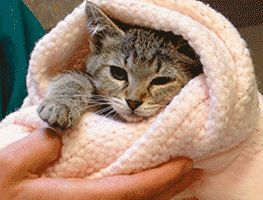Litter Box Success
Tips for setting up your cat for issue-free litter box usage
While there are some cats who will use their litter box regardless of the set-up, many cats have stronger preferences and require ideal conditions for consistent litter box usage. When bringing a new cat into a new home, it is important to set them up for litter box success regardless of their history with litter box usage. The below recommendations should be followed when welcoming your new cat home.
- When introducing your new cat into the home, confine the cat to one room with litter boxes, a bed, food, and water. The cat should remain in this room until they have used the litter boxes consistently for at least one week. It is okay to use just one litter box during this period if your cat will be confined to a small space such as a bathroom. When your cat shows an interest in exploring the rest of the house you can begin to slowly introduce them to the rest of the home. This should be a slow process and time out of the room should be supervised. If you have other animals in the home, check out the handout on introducing your new cat to resident animals for more details on proper introductions.
- The rule of thumb for the number of litter boxes is: one per cat in the household, plus one. Extra litter boxes are necessary because some cats like to defecate in one and urinate in another. Others will not use a box that has already been used by another cat. The litter boxes should be uncovered and at least 22" x 16" for an adult cat.
- Place additional litter boxes in quiet, private places that are easily accessible to the cat and where they will not be disturbed by children or ambushed by other animals. Noisy areas near washing machines, furnaces or under stairs may frighten the cat away from the box. A house with multiple stories should have a litter box on each floor. Different areas for the litter boxes can prevent location-avoidance problems. NEVER place litter boxes near food and water dishes. Once you have decided on the placement for the litter boxes in your house, do not move them.
- Use an unscented, sand-like scoopable litter. Perfumed, chemical scents repel cats. Be sure to select a brand that clumps into a firm ball, making scooping easier and cleaner.
- Do not use litter box liners—these can be irritating to some cats. Also, covered or hooded litter boxes can be offensive to cats as they do not satisfy the cat's need for escape potential when eliminating. They also trap the odor inside, creating an "outhouse effect."
- Clean the litter boxes DAILY. The single most common reason for a cat's refusal to use a litter box is because the box is dirty. The litter should be scooped daily and the litter boxes washed when soiled, or at least once per month. (Bacteria left in the litter boxes will smell to the cat, even if you can't smell it.) When washing the litter boxes, use hot water and an unscented dishwashing liquid. Do not use harsh chemicals that will leave a lingering odor.
- Cats find consistent routines and predictable environments very comforting, so try to keep your cat’s activities on a schedule. Playtimes, mealtimes, and bedtimes should occur approximately the same time every day. The less stress your cat experiences, the less likely they are to have litter box issues.
If you experience litter box issues after following these recommendations check out the handout on Solving Litter Box Problems. If you have additional questions contact the Wisconsin Humane Society behavior team at asktheexpert@wihumane.org or 414-431-6173.


